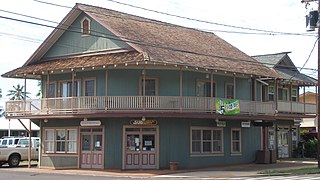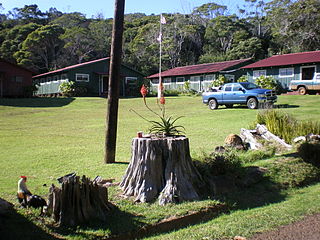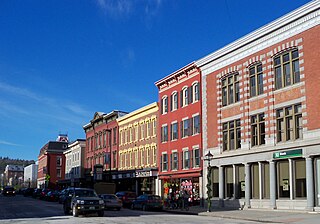The National Register of Historic Places (NRHP) is the United States federal government's official list of districts, sites, buildings, structures and objects deemed worthy of preservation for their historical significance. A property listed in the National Register, or located within a National Register Historic District, may qualify for tax incentives derived from the total value of expenses incurred in preserving the property.

The King David Kalakaua Building in Honolulu, Hawaii is a government building formerly known as the U.S. Post Office, Customhouse, and Courthouse. It was the official seat of administration in the Territory of Hawaii and state of Hawaii for the United States federal government.

Grand Canyon Village Historic District comprises the historic center of Grand Canyon Village, on the South Rim of the Grand Canyon in Grand Canyon National Park, Arizona. The district includes numerous landmark park structures, many of which are National Historic Landmarks themselves, or are listed on the National Register of Historic Places. The town design as a whole is also significant for its attention to integration with the Grand Canyon landscape, its incorporation of National Park Service Rustic design elements, and for the idiosyncratic design of park concessioner structures such as the El Tovar Hotel.

The Cook Landing Site in Waimea on Kauaʻi island in Hawaii, is where Captain James Cook landed at the mouth of the Waimea River on January 20, 1778. Cook was the first European reported to have sighted the Hawaiian Islands, and the January 20 landfall on southwestern Kauaʻi was his first arrival upon Hawaiian soil. Cook Landing Site was registered as a National Historic Landmark on December 29, 1962. The landing is principally commemorated at Hofgaard Park, a small county park located near the supposed landing site.

The Yamase Building at the corner of Moana Road and Kaumualiʻi Highway in Waimea, Kauaʻi, was built around 1919 by an itinerant Japanese temple architect for Seiichi Yamase, a nisei son of Japanese immigrants. Despite being the only structure of its kind in Hawaiʻi, it well represents both commercial architecture in rural Hawaii and the contribution of immigrants to the growth of commerce there. It was listed on the National Register of Historic Places in 1996.

The Chee Kung Tong Society Hall was a former Chinese society hall located on 2151 Vineyard Street in Wailuku, Maui. Built to provide services to single immigrant Chinese males, mostly working for the sugarcane plantations, it provided religious and political help, in addition to mutual aid. Converted to a dormitory in the 1920s, it suffered neglect until finally collapsing in 1996. The site now contains remnants of the foundation, assorted cement structures, and a distinct lintel gate and wall facing the street. The site was placed on the Hawaii State Register of Historic Places and the National Register of Historic Places, but delisted from the State register after its collapse; it is still listed in the NRHP database.

The Wailuku Civic Center Historic District is a group of four historic buildings and one non-contributing property in Wailuku, Maui Hawaii that currently house the governmental offices of both the County of Maui and the State of Hawaii. The historic buildings were built during a time span from 1901 to 1931. They incorporate several architectural styles and two of the four historic buildings were designed and built by Hawaii-based architect C.W. Dickey. The non-contributing property houses most of the County of Maui's main offices.

The Harvey H. Cluff house is a house in central Provo, Utah, United States, built in 1877 that is on the National Register of Historic Places. It was originally owned by Harvey H. Cluff.

The Albert Spencer Wilcox Building is a historic building in Līhuʻe, Kauaʻi, Hawaii. Originally a library when it opened in 1924, it was later converted into the Kauaʻi Museum. It has exhibits on the history of the island of Kauaʻi. It was added to both the Hawaiʻi Register of Historic Places and the National Register of Historic Places in 1979.

Waihee Church is a historic church in Waihee, Hawaii, United States. The church began construction in 1848 and finished ten years later in 1958. It is located on a small parcel heavily planted with trees and flowers in the plantation town of Waihee. The church was established for Waihee's missionary congregation. Johnathan S. Green first established the church by building a thatch and pole meeting house on the present site in 1803. Early records indicated that between 100 and 300 Hawaiians attended the early meetings. The church is significant for its architecture. It was built with lava rock and has a limestone foundation and wooden siding. A wooden bell tower originally topped the building; however, it was removed in 1987 due to termite and storm damage. In 1930, the church was devastated by a flash flood cascading from the mountains at the back of the church property. It is still standing today but most of the church records were destroyed. Waihee Church is a historic landmark and museum. The church became an official branch of the Kaahumanu Church in Wailuku in 1868.

Civilian Conservation Corps Camp in Kokeʻe State Park is located at Hawaii Route 550, in Waimea, on the island of Kauai, in the U.S. state of Hawaii. It was built in 1935 with lumber that was put into the saltwater and floated to the shore at Port Allen, the seawater adding a natural termite protection to the lumber. The camp was in continual use for forest management, until Hurricane Iwa devastated it in 1982. In the 1990s it was restored through the efforts of the non-profit Hui O Laka environmental group, and is currently open to the public. It was added to the Hawaiʻi Register of Historic Places and the National Register of Historic Places on December 20, 1996.
Architects of the National Park Service are the architects and landscape architects who were employed by the National Park Service (NPS) starting in 1918 to design buildings, structures, roads, trails and other features in the United States National Parks. Many of their works are listed on the National Register of Historic Places, and a number have also been designated as National Historic Landmarks.

The First Bank of Joseph, at 2nd and Main Sts. in Joseph, Oregon, is a 25-by-91-foot historic building that was built in 1887. It was listed on the National Register of Historic Places in 1978.

The Gulick-Rowell House, on Missionary Row in Waimea, on Kauai, in Hawaii, is a historic house that is listed on the U.S. National Register of Historic Places. It is located across from Waimea Canyon Middle School, on way to Kauai Veterans Memorial Hospital, first built 1829 by Rev. Peter Johnson Gulick, completed by Rev. George Rowell in 1846.
The Charles Gay House, on Gay Road in Waimea, Kauai, Hawaii, was built in 1895. It has also been known as the Roland Gay Residence. It was listed on the Hawaiʻi Register of Historic Places and the National Register of Historic Places (NRHP) in 1984; the NRHP listing included three contributing buildings.
The Kilauea Plantation or Kilauea Sugar Plantation was a large sugarcane plantation on the north side of Kauai island, Hawaii, including the community of Kilauea, Hawaii. It was owned and operated by the 1880-incorporated Kilauea Sugar Company, which became the Kilauea Sugar Plantation, Co. from 1899 on. The original property was bought by an American, Charles Titcomb, from Kamehameha IV by 1863 who used it for cattle ranching. It was sold to Englishmen John Ross and E.P. Adams, who also leased additional land from Titcomb. Ross and Adams planted sugarcane, then incorporated a firm. It was operated as a plantation from 1880 to 1971.

The Montpelier Historic District encompasses much of the historic commercial and government district of Montpelier, the state capital of Vermont. The city center, focused on the confluence of the Winooski River with its North Branch, has been economically driven by state government since 1805, and had industry powered by the rivers. Its center reflects a diversity of 19th century architecture. In addition to the Vermont State House, the district includes The Pavilion, the commercial downtown area, and residential areas to the east and north. It was listed on the National Register of Historic Places in 1978, and enlarged in 1989 and 2018.

The Old Red Mill and Mill House are a historic 19th-century mill building and residence on Red Mill Drive in Jericho, Vermont. The mill was built in 1856 and enlarged later in the 19th century, accommodating then state-of-the art grain rollers, and was a prominent local business. The house was built in 1859, and is a good local example of Gothic Revival architecture. The mill is now a museum property of the local Jericho Historical Society. The mill building was listed on the National Register of Historic Places in 1972; the listing was expanded to include the house in 1976.

The State Bank of Kooskia in Kooskia, Idaho was built in 1912. It was listed on the National Register of Historic Places in 1978.
James King was an early architect in Idaho. He was the first formally trained architect operating in the state.



















